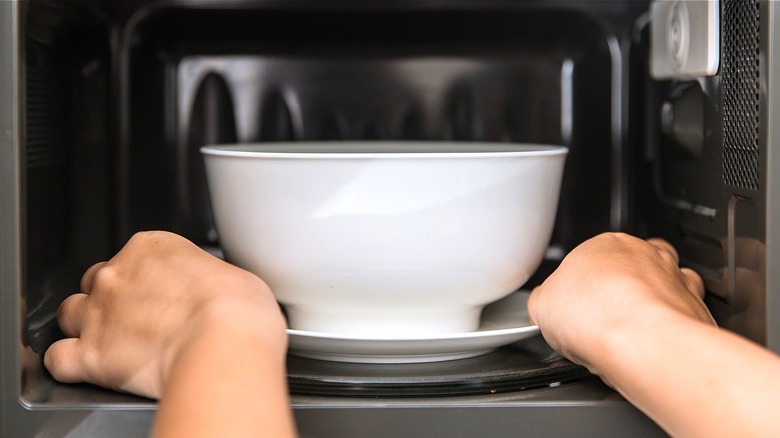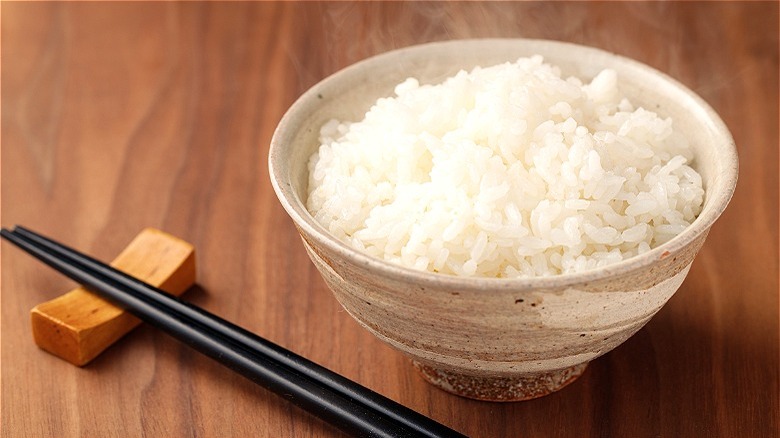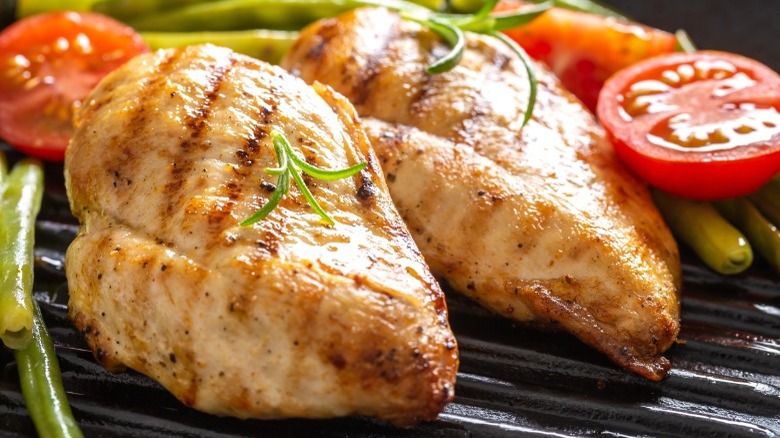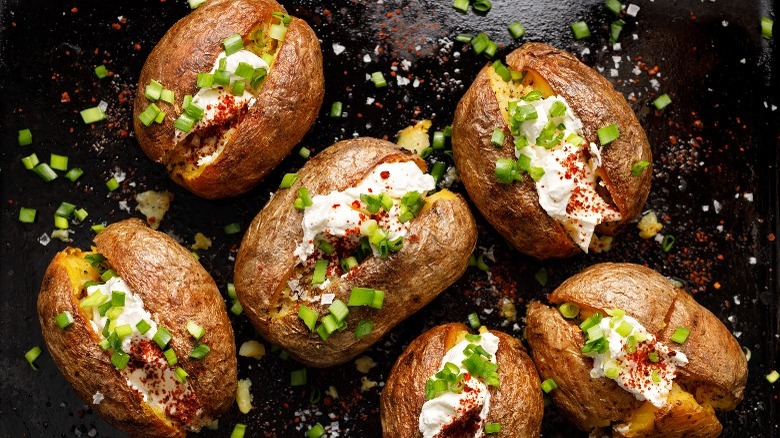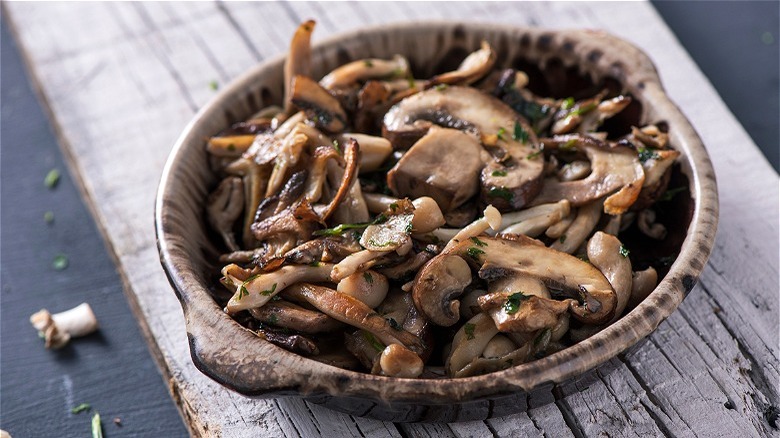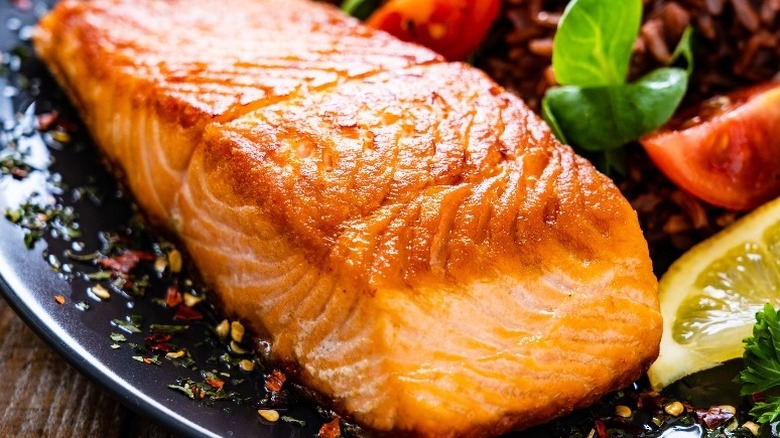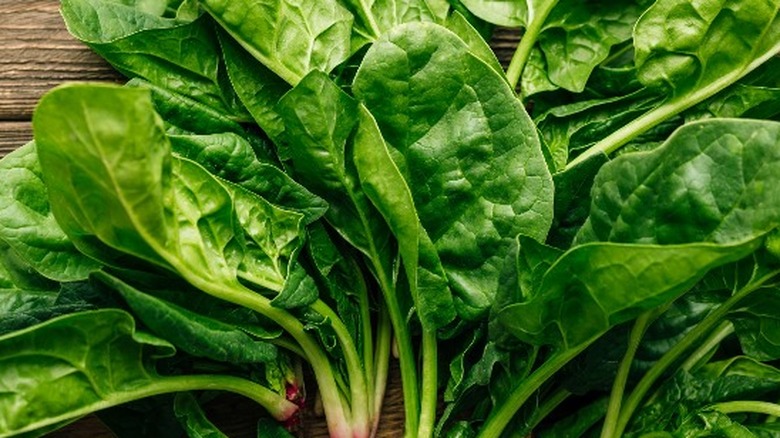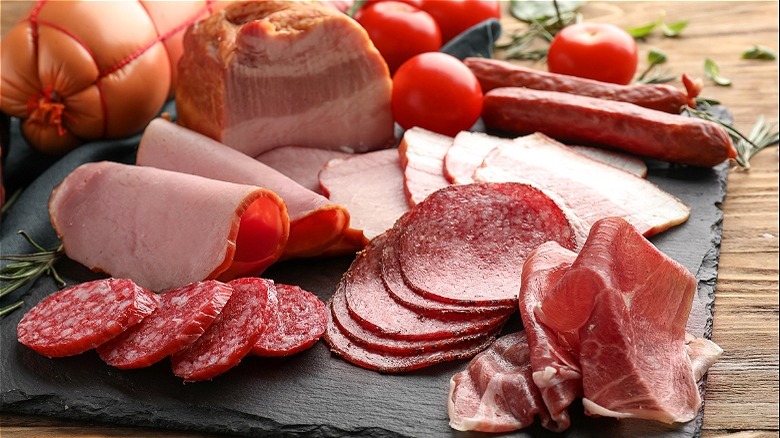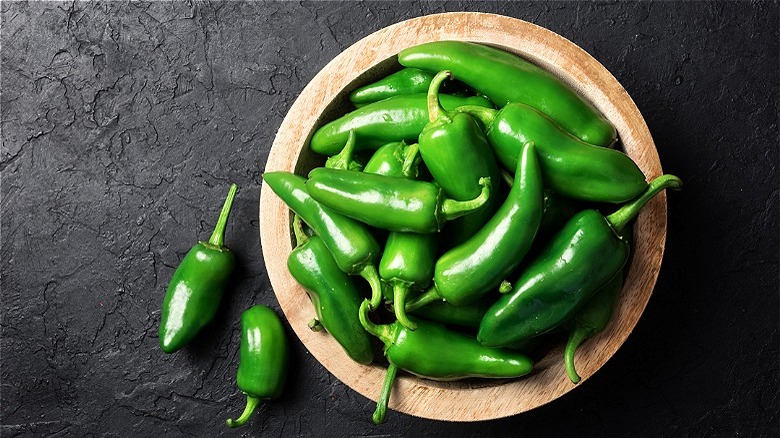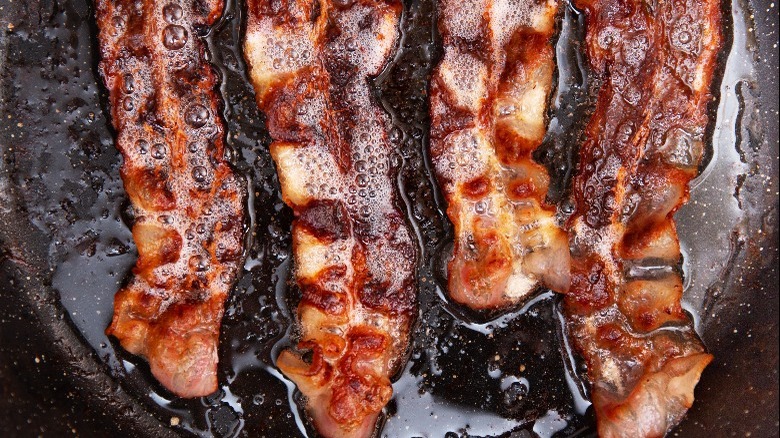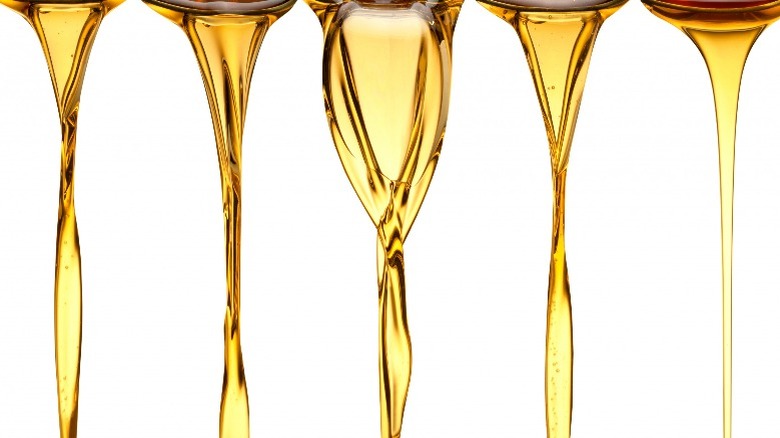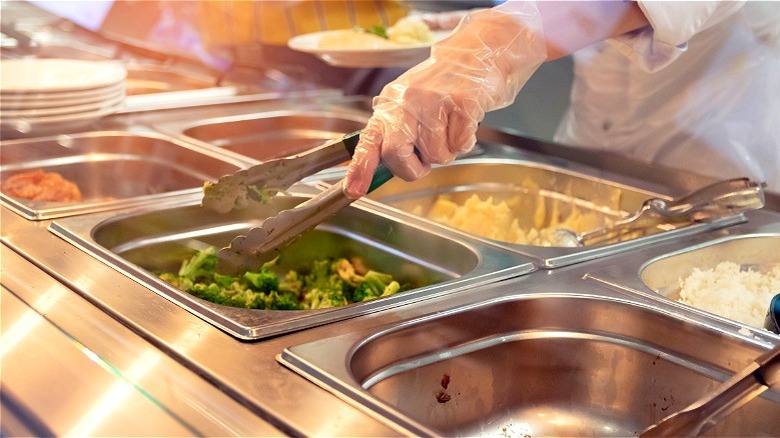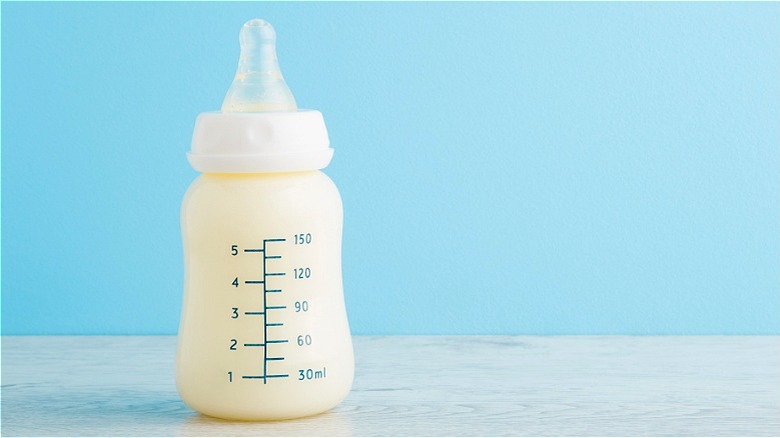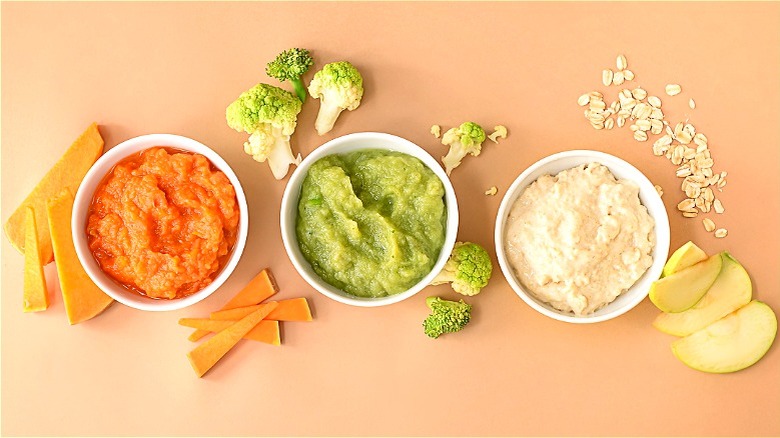Foods That Can Actually Become Toxic When Reheated
If you are someone who cooks often, it's hard to not end up with leftovers. You might be feeding other people in addition to yourself, or you might just be cooking for one. Either way, it's hard to anticipate how much food will be eaten. Plus, leftovers don't seem like the worst outcome — at least that's one less meal to cook in the future, right? Well, wrong, actually. Certain foods should never be kept as leftovers, much less reheated for a second meal.
The reasons certain foods may become toxic once reheated can vary. It may be that food has been stored improperly, and once reheated, it becomes inedible. It could be that the food was stored too long and has passed its expiration date, or it might be that you aren't reheating the food to the correct temperature. Whatever the reason, the food isn't safe anymore and should not be eaten.
Reheating potentially toxic foods isn't something to be taken lightly. Sure, there are some myths about microwaves that aren't worth your time. However, sickness, death, or even amputation as the result of food poisoning from leftovers have all occurred before. It's not worth taking the risk of reheating those Tupperware containers just for the ease of a free meal. Avoid disaster by reading on: these are foods that can actually become toxic when reheated.
Rice
Eating leftover rice can be dangerous. Bacillus cereus, bacteria that causes food poisoning, is the main source of concern. Per the National Health Service (NHS), spores of bacillus cereus can be present from the very beginning on rice, even on uncooked grains. Those spores can also remain on cooked rice. However, if cooked rice is left to sit out too long at room temperature, those spores begin to grow bacteria. This is when the real risk for food poisoning begins.
You want to avoid eating this toxic rice as much as possible. According to the BC Centre for Disease Control, symptoms of food poisoning caused by bacillus cereus include vomiting, nausea, diarrhea, and abdominal pain.
To avoid getting sick from leftover rice, you can take a few steps. First, let your cooked rice cool quickly, ideally within 1 hour of cooking. This limits the time the rice is within "the danger zone," between 40-140 degrees Fahrenheit, per the US Department of Agriculture's (USDA) Food Safety and Inspection Service. You can store cool rice in the refrigerator for 3-4 days. During storage, your leftover rice may become hard and dry, slimy, or stinky. These are signs your cooked rice has gone bad. While reheating, make sure your rice reaches 165 degrees Fahrenheit. Either the microwave or the pan will do (via Real Simple). You must follow these food safety steps from start to finish because, as the University of Florida explains, proper reheating isn't always enough to kill Bacillus cereus.
Chicken
Reheating chicken has its risks. Most people are familiar with the bacteria present in raw chicken, such as salmonella, clostridium perfringens bacteria, and campylobacter bacteria (via Centers for Disease Control and Prevention). However, these bacteria can remain on chicken if the meat is cooked or reheated incorrectly. As the San Francisco Gate explains, you can get food poisoning caused by salmonella if your chicken doesn't reach the correct temperature when it's reheated.
Reheated chicken can expose you to foodborne illnesses with serious consequences. Salmonella can cause death, but rarely. People most likely to suffer death or other severe salmonella symptoms are those in vulnerable groups, such as the elderly, children, pregnant people, and individuals with compromised immune systems (via Healthline). More common, less serious Salmonella symptoms include stomach pain, headaches, chills, fever, diarrhea, or nausea.
Luckily, you can avoid these side effects by taking precautions when reheating your chicken. After cooking the chicken to the proper temperature (165 degrees Fahrenheit), you should put it away within 1 hour, as with cooked rice. Once stored in the refrigerator, the cooked chicken will last 3-4 days (via USDA). When it's time to reheat, you need to bring the entire chicken's temperature back up to 165 degrees Fahrenheit. Some people think this can't happen if they reheat chicken in the microwave. Others, like Healthline, think the safest bet is reheating your leftovers the same way they were first cooked. Using a meat thermometer can eliminate the guessing game.
Potatoes
Just like rice, potatoes are a starchy food that you should be careful when reheating. Both rice and potatoes are carbohydrate-rich foods that contain the bacteria bacillus cereus, which causes food poisoning. If not properly stored or warmed to the correct temperature, the bacteria can grow on leftover potatoes, making them toxic to eat.
Potatoes have even been linked to cases of botulism, which the Centers for Disease Control and Prevention describes as "a rare but serious illness caused by a toxin that attacks the body's nerves." Per the USDA, a botulism outbreak that occurred in 1997, affecting 17 people, was traced back to potatoes. Even as recently as 2020, an 80-year-old woman died of botulism caused by potatoes. According to Food Safety News, the source of the botulism was "potatoes stored at room temperature for two weeks." As the Food Poisoning Bulletin explains, the greatest risk for potato-based-botulism comes from baked potatoes stored in the fridge in aluminum foil. The foil "can create a low oxygen environment where the pathogen can grow and produce the toxin." Being in the fridge doesn't help.
The best way to avoid these potato-borne illnesses is through safe storage. After cooking your potatoes, remove all aluminum foil. Store the potatoes in shallow, air-tight containers or plastic bags for 3-5 days (via StillTasty). For safety, eat them as soon as possible. When reheating them, err on the side of caution to make sure they are piping hot and cooked through (via Southern Living).
Mushrooms
Leftover mushrooms are another food you want to handle cautiously. Like potatoes, there are concerns about botulism associated with mushrooms. As Consumer Health Digest explains, that's because mushrooms are low-acid vegetables. Foods with a PH level lower than 4.6 can't grow the bacteria that causes botulism infection (C. botulinum), according to the World Health Organization. However, less acidic foods like mushrooms can grow it.
If you combine cooked mushrooms with low oxygen environments (through improper storage), the risk for botulism is even higher. E. Coli, salmonella, and other bacteria that can cause food poisoning or even death (via Consumer Health Digest), can also be spread through cooked, leftover mushrooms (via Psyhio-Pedia).
To avoid regrettable errors in cooking, storage, and reheating mushrooms, listen up — as with the other leftovers on this list, you should cool the mushrooms ASAP after their first cooking before putting them in the fridge. Per Valuable Kitchen, you should also set your refrigerator's temperature between 36-38 degrees Fahrenheit. This ensures your fridge foods stay out of the USDA's aforementioned "danger zone," which begins at 40 degrees Fahrenheit. The mushrooms should last 3-5 days (via StillTasty). When reheating, Valuable Kitchen says you can use the microwave, oven, or stovetop. Just be sure the mushrooms reach 165 degrees Fahrenheit before you begin eating.
Seafood
Leftover seafood is another thing that can become toxic to reheat and eat. According to the American Academy of Family Physicians, there are two ways to get poisoning from fish: scombroid poisoning and ciguatera poisoning. Scombroid poisoning (aka Scombrotoxin or histamine poisoning) occurs after eating fish that have "high levels of histamine due to improper food handling" (via Johns Hopkins Medicine). As for ciguatera poisoning, there are over 400 species of fish that naturally contain the toxin, which creates this illness. You can't stop ciguatera poisoning through proper food safety, but other forms of seafood-based food poisoning can be prevented.
First, you need to choose seafood that hasn't gone bad, to begin with. Per the FDA, that means buying seafood that was immediately caught and then frozen. You can also purchase "previously frozen" fish, but make sure it doesn't smell pungent or appear discolored. Frozen seafood may also be thawed in the refrigerator soon before cooking.
Once you have cooked seafood ready to store for leftovers, you want to follow many of the aforementioned food safety tips. Store the cooked fish in a refrigerator set below 40 degrees Fahrenheit within 2 hours of cooking, and eat it within 4 days of storing (via LiveStrong). When reheating, make sure that the leftover fish is cooked entirely through. Test the seafood to make sure every inch of it has reached 165 degrees Fahrenheit. From Hunger to Hope recommends using the oven or the stove and skipping the microwave.
Nitrate-rich vegetables
In the food safety world, there's concern surrounding the reheating of nitrate-rich vegetables. Unlike the food poisoning caused by leftover chicken, rice, or seafood, the way that nitrate-rich vegetables become toxic is a little different. The reheating itself is the part that is thought to be dangerous. Concern surrounding nitrites and nitrates comes from both compounds' links to diseases like cancer (via Healthfully). However, it's not easy for them to become toxic.
As LiveStrong explains, you don't need to worry too much about exposing yourself to harmful nitrates through vegetables. The real concern comes from synthetic nitrites or nitrates, like "sodium-potassium nitrate or nitrite," which are usually found in processed foods such as hot dogs or bacon. When these compounds enter the body, they are converted into "nitrosamines," which the Environmental Working Group says are where the real health risks come from. Also, you don't need to be too afraid of consuming vegetables high in nitrate, as they contain other vitamins that prevent them from becoming harmful nitrosamines.
Foods high in natural sources of nitrate include vegetables like spinach, bok choy, lettuce, and carrots (via WebMD). If you reheat any of these nitrate-rich vegetables and they become dried up or shriveled, you would be concentrating the amount of potentially harmful nitrates in your meal (via Verywell Fit) and exposing yourself to them. To avoid making your food toxic, don't overcook your leftover vegetables into a shriveled-up mess.
Processed meats
Reheating processed meat contains the risk of exposing yourself to synthetic nitrates. These nitrates, although used to preserve the shelf life and color of processed meats (via the Food Safety Authority of Ireland), can be harmful to your health.
The other health concern is cholesterol oxidation products (COPs), which are the main reason some think you should never microwave processed meat. That's because some research shows that heating animal products results in the formation of cholesterol oxidation products, which have been linked to disease (via Food Control).
Some think the effects are even worse when processed meat is heated in the microwave, which has been shown to produce more of these cholesterol oxidation products than other forms of heating (via Lipids in Health and Disease). To make matters worse, diseases like coronary artery disease are associated with ingesting cholesterol oxidation products (via the Indian Journal of Clinical Biochemistry). Imagine reheating those processed meats a second time — and possibly exposing yourself to even more COPS, as they are called. We can all avoid this by not reheating our processed meats — like hot dogs, sausages, bacon, salami (via NBC News) — or doing so in the microwave.
Spicy Peppers
The toxic impact of reheating spicy peppers is much more immediate, compared to these other foods. If you reheat hot peppers in the microwave, a few terrible things can occur.
Worst case scenario, you end up like the New York state individual who attempted to microwave a spicy pepper and caused an explosion that released the pepper's spice into the air. Per ABC 13, this particular microwaved pepper made it hard for building residents to breathe, even creating a "pepper spray" effect, causing them to cough. The building ultimately had to be evacuated.
This situation likely occurred because hot peppers contain capsaicin, which is what makes them hot. The amount of capsaicin per kind of pepper is even used to determine just how hot each pepper is (via Pepper Seeds). Because of the capsaicin in hot peppers, heating them makes it an airborne toxin, creating the same (or worse) symptoms of biting into a spicy pepper, as Insider explains.
Sometimes, worse things can happen. When you put a hot pepper in the microwave, it can explode (via Can You Microwave This?). Not only could this create a mess in your microwave, but the pepper could also catch on fire. Skip the microwave, if you must take the risk of reheating your spicy pepper at home.
Pork
You may have tried to reheat a few different pork products in your day. Pork can sometimes come in the form of processed meat. For example, bacon, Canadian bacon, or ham are all forms of processed pork (via the American Meat Science Association). As we know, risks come with reheating processed meat, such as the possible exposure to harmful synthetic nitrates or cholesterol oxidation products. On the other hand, there are forms of unprocessed pork — such as pork chops, pork loin, or pork ribs (via Cancer Treatment Centers of America) — which may also become toxic as leftovers.
Trichinosis is one of the most common forms of food poisoning associated with pork. This foodborne illness comes when someone consumes raw or undercooked pork which has been contaminated with the larvae of a worm called trichinella spiralis (via the Cleveland Clinic). Once the parasite enters your body, it creates uncomfortable side effects such as diarrhea, constipation, abdominal pain, headaches, chills, and more. This nightmarish form of food poisoning should be avoided at all costs. If you don't reheat pork to the proper temperature, you might be at risk of contracting trichinosis.
Additionally, you may be susceptible to other foodborne illnesses, like salmonella and listeria, if your leftover pork is heated incorrectly. Per Food Safety News, you should always reheat your pork to at least 165 degrees Fahrenheit to avoid food poisoning, in addition to following other common food safety practices in cooling, storage, and following use-by dates.
Oil
Learning about all the risks associated with reheating cooking oil might change your life. You might start to think twice about reheating that leftover Chinese food or pizza slices. Per NDTV, reheating oil could potentially make the oil more carcinogenic, increase the amount of cholesterol, or make it more acidic. According to the outlet, additional side effects like weight gain, heart disease, obesity, and diabetes could also occur when you ingest reheated oil.
As The Times of India notes, there are even more health risks associated with reheated oil. Reheating can increase the amount of "aldehydes," which are associated with diseases like Alzheimer's and Parkinson's disease, as well as other illnesses. Also, reheated oil can raise the number of free radicals, which can negatively impact your health. For something as ubiquitous as oil, there are many potentially toxic effects involved with reheating it.
Tossing your oil-covered leftovers is the easiest solution to this problem. It can be hard to make sure your food is heated to a safe 165 degrees Fahrenheit, all while making sure that the oil the food is covered in is not overheated. KMP Oil recommends some tips if you must reuse cooking oil. Limit the oil amount, avoid high temperatures, don't deep-fry anything, and don't add salt during deep-frying.
Buffett food
This is probably more common sense than scientific knowledge, but you shouldn't reheat leftover buffet food. As with other leftovers, that's because the original food was possibly not kept fresh enough, to begin with. According to the Minnesota Department of Health, potentially toxic causes of foodborne illnesses like norovirus, salmonella, and E. coli can be spread through buffets. Buffet food becomes toxic when it is not reheated to an adequate temperature, or kept hot enough while it's being stored in trays.
The FDA outlines several rules which buffets must follow to ensure food safety. It explains that hot food must be heated to 165 degrees Fahrenheit before serving and then stored in containers heated to 140 degrees Fahrenheit. Cold food must remain under 40 degrees Fahrenheit. If food is left at room temperature, it must be thrown away after 2 hours. If it's hotter than 90 degrees Fahrenheit outside, the time before disposal is reduced to 1 hour.
With so many guidelines in place, one can't be sure that the buffet you're at is following all the rules. As a result, when you take your buffet leftovers home, you may be saving food harboring bacteria. Sure, you may be able to kill some of the bacteria through reheating. However, if the bacteria-covered food was out long enough, it won't go away easily. Per the New York Times, even boiling temperatures (212 degrees Fahrenheit, per Britannica) won't kill this type of bacteria completely.
Breast milk
Even less common than reheated buffet food, breast milk isn't something we all find ourselves popping into the microwave daily. For parents of newborns, however, heating milk for their babies is something that needs to happen often. However, if done incorrectly, the process of reheating milk could be harmful to infants.
Per the CDC, microwaving breast milk can destroy beneficial nutrients and potentially burn a baby's mouth. That's why a microwave should never be the method used to thaw breast milk or reheat it.
Instead, the FDA recommends reheating breast milk using different methods. You can heat breast milk by placing a baby bottle under hot, running water until the bottle is hot. Alternatively, you can heat water in a pan, remove the pan from heat, then temporarily place the bottle into the water-filled pan. According to The Baby's Brew, breast milk should be heated to body temperature (98.6 degrees Fahrenheit). If breast milk is heated to 104 degrees Fahrenheit, it could damage the milk. Play it safe by safely reheating your milk to body temperature using FDA-recommended methods.
Baby food
Any method of reheating leftovers for babies can be risky. That's because babies are particularly vulnerable to foodborne illnesses and their symptoms. As WebMD explains, children under age 5 have weakened immune systems that make it harder for them to fight food poisoning. If you must reheat your babies' food a second time, here are a few precautions to take. Once opened, baby food lasts a maximum of 3 days (via the FDA).
While reheating, Baby Center recommends using a thermometer to make sure the food's temperature has risen to 165 degrees Fahrenheit. Certain foods will require a lower temperature, but especially if there is a mix of different ingredients in your baby's puree, you'll want to play it on the safe side. Annabel Karmel recommends making sure the baby's food is "piping hot" (another common piece of food safety knowledge). You can do this by stirring the baby food to make sure it is steaming. Don't worry, you don't have to serve it to your baby at this temperature — just make sure it reaches this state at one point before serving.
Per Homemade Baby Food Recipes, if you must reheat your baby food, do it only once. Don't try to reheat your leftovers a second time. As BBC Good Food explains, this is a common recommendation for all leftovers, because the more times you reheat and cool your food, the more potential there is for food poisoning.
